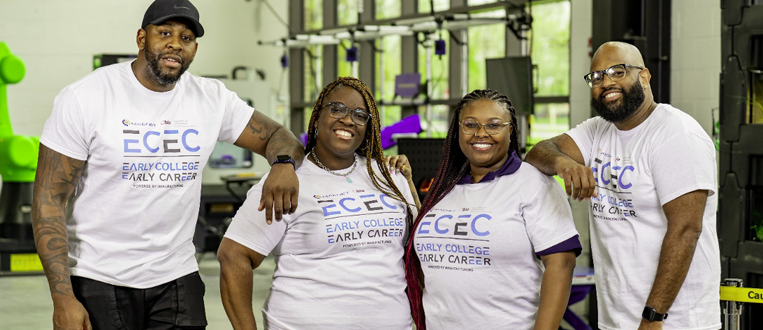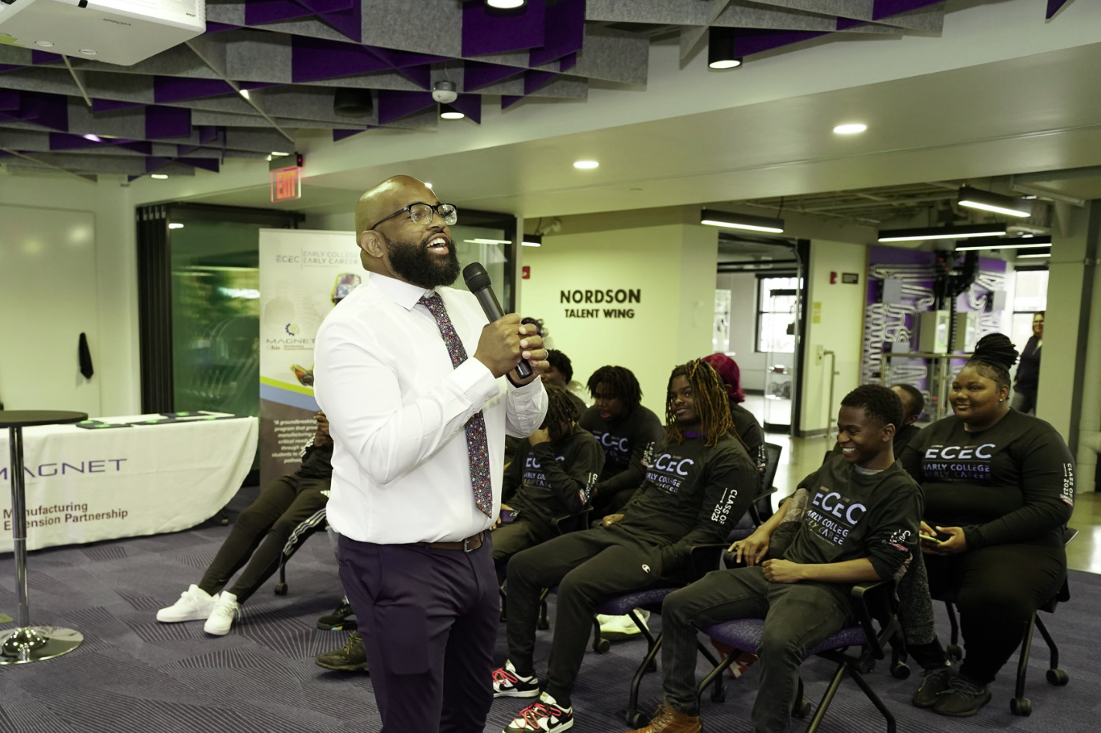Manufacturing Innovation Blog
Powered by the Manufacturing Extension Partnership
Want to Replicate the German Apprenticeship Model? Look No Farther Than Cleveland for Inspiration

Some of the ECEC team (left to right): Marvin Rashad, Monica Dawson, Cydney Davidson-Bey, and Rahim Nichols.
When I first started at MAGNET (part of the Ohio MEP) in 2015, I walked into my new office, and there was a whitepaper sitting on my desk. In it, our former Board Chair Felix Brueck outlined how we could adapt the German apprenticeship model of workforce development to Northeast Ohio and reap real benefits for the Greater Cleveland area.
That incredibly effective German model, which we’ve discussed many times on this blog, could bring manufacturing awareness, certifications, and work experience to Cleveland’s inner-city students, just 15% of whom (at the time) were graduating from any form of college. Brueck referred to manufacturing as the “social elevator” and, through his dedication, the support of numerous pioneering funders, and the hard work of many MAGNET colleagues over the years, the Early College, Early Career (ECEC) program has graduated 119 students to date. That means dozens of people’s careers launched in manufacturing, their families assisted through education and growth, and their communities slowly being revitalized through these living-wage positions.
In this blog post, I interviewed ECEC’s Director Rahim Nichols and Monica Lawson, the Education Coordinator, so they could share their knowledge with you, our fantastic readers.
Let’s start at the top. What are the goals of the Early College, Early Career (ECEC) program?
Rahim: We want to create a talent pipeline to help fill the thousands of open manufacturing jobs in Northeast Ohio. Specifically, we want to offer local manufacturers the chance to tap into a talent pool they don’t normally consider: high school youth. By making these young people available to manufacturers and supporting them both before and after their internship placements, we’re creating new opportunities for both the students and the companies.
I know ECEC recently wrapped up its fifth cohort, so it’s now five years old. Tell me about the evolution of the program.
Rahim: We’ve learned a lot along the way. Our first few cohorts really struggled with attrition, with 30-40% of students dropping out along the way. In addition, not many students were actually choosing manufacturing after graduating the program. We’ve addressed this in two ways. First, really investing in our in-house mentorship program, so students feel more supported. And second, we adjusted our recruitment strategy so we’re attracting the right kind of student, meaning, those who never considered manufacturing but, given college might be too expensive or just not interesting to them, they’re willing to give it a shot.
Monica: And these changes have really paid off. Attrition is now much closer to 20%, and the number of graduates choosing manufacturing has risen as high as 70% for some cohorts. We’re building this plane as we fly it, and we get better with every cohort.
Rahim: We have 50 students in our current cohort, and we’re gearing up to recruit 100 for next year.
What are some of the key reasons ECEC has been successful?
Rahim: I would attribute our success to three things. First, we were able to pivot during COVID, broadening our mission to include supporting the students and their families through a really tough time. Second, we offer in-person, individualized mentorship for participants. That authenticity and genuine connection with the students keeps them engaged. Third, we’re changing perceptions for our students. We’re exposing them to these careers for the first time, and we’re showing them that college is not the only route to being successful. These realizations are really impactful for our students and give them access to new post-secondary opportunities they wouldn’t have otherwise.
Monica: I love all that, and I would add family engagement as a critical component. We make sure the parents are not only on board for this journey, but they’re encouraged to take a plant tour, attend various seminars, and more. We know it takes a village, and we’re really committed to that approach.
Tell me about the ECEC timeline. How does it work on the ground and in these schools?
Rahim: Student recruitment starts in junior year. We start in September with basic presentations covering what ECEC is, what the benefits are, and what the commitments are. Students then indicate their interest using a QR code. Schools are partners and will review that list and give us feedback on each applicant’s attendance and attitude. We’re not hung up on a student’s grades. It’s more important that they’re going to take full advantage of this opportunity.
Monica: Programming starts with family orientation at the end of January. At that time, the student’s parents are formally introduced to the program. Once the students are accepted by their companies, we start with company shadow days, allowing them to see their worksites without any pressure to work. Alongside company shadow days, students receive soft skills and workplace readiness training by ECEC staff. Then, we transport them to their internships starting in the summer. We continue to expand this model to offer more activities, team building, and chances to learn about manufacturing.

Soft skills are obviously important as well. How does MAGNET teach high school students about professional conduct?
Monica: Our official programming starts in February of junior year. We use the “Bring Your ‘A’ Game” curriculum, with sessions once per week at MAGNET. We teach the “7 A’s” of professional life:
- Attitude
- Attendance
- Appearance
- Ambition
- Acceptance
- Accountability
- Appreciation
Soft skills training runs February to May, with a field trip to a local career center and local community colleges so they can see what manufacturing programs look like. Finally, they do a shadow day with their company, so they spend two Fridays simply shadowing and meeting their new colleagues. The idea is to prevent the anxiety of starting the first day of work.
How does MAGNET work with the employers to increase the chances of the student succeeding on the job? And if there’s an issue between the student and the company, what happens?
Rahim: First, we’re in consistent contact with companies. Companies fill out a bi-weekly form that tells MAGNET if their students need coaching, congratulating, or correcting. Whenever there’s an issue, our internship coaches (Marvin Rashad, Cydney Davidson-Bey, and Kiara Chatman) are the first line of response. MAGNET will be on site the same day, often within an hour, if necessary. We address issues as soon as we can. Two other full-time mentors are on staff to help. Essentially, we immediately get involved whenever there’s an issue, so there are no surprise disciplinary actions being taken against the student.
Monica: We have a range of interventions at our disposal. We can coach, correct, congratulate, provide on-site mentoring, call for a student/supervisor conference, or create a Student Improvement Plan, to name a few. But in general, we want to celebrate our students. That’s why we have a “student of the week” post on our Instagram page. For the students who finish that first summer, we do a Summer Celebration. We invite the students, company supervisors, school staff, and parents, and give out awards for things like best reviews, perfect attendance, overcoming obstacles, and more.

You’ve both been to Germany on the America Works Stronger Together Missions. What struck you about their workforce development system?
Rahim: I love the way student development is ingrained in the system. Everyone believes, everyone takes ownership. If we can get to that place – where the schools believe, the employers invest, and the community sees the workforce pathway – that will really further our cause.
Monica: I love that that students are paid throughout the experience – for both the education and the work. Those two pieces are valued equally.
Last question: For communities that are interested in learning more, or even replicating the ECEC model, who should they talk to?
Rahim: Our ECEC program was built to be scaled nationally. I’d love to talk to interested communities. Just rnichols [at] manufacturingsuccess.org (subject: ECEC%20Inquiry) (email) me!


